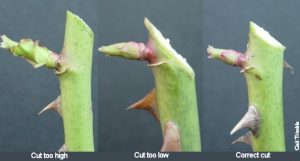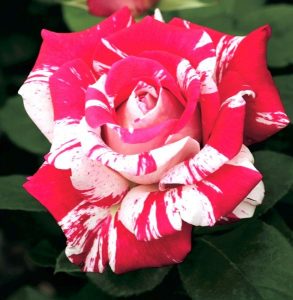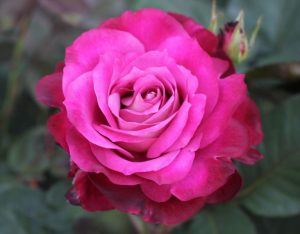Plums are in bloom, forsythia are covered in yellow flowers, and my fragrant rosemary is in glorious flower. Spring is so early this year that we decided to ship the first rose crop into the nursery, a full two weeks earlier than usual! They arrive this week.
My annual rose pruning article usually appears in March, but not this year. Roses have been awakened by the unusually warm weather and need to be pruned for good health and abundant blossoms this spring.
 Now through the middle of March is the ideal time to clean up your roses. Pruning roses seems to dumbfound many gardeners, but it doesn’t have to be so intimidating. The main objective is to cut back hard; it’s difficult to make a mistake. The fact that mistakes grow out is the uncertain pruner’s salvation! Fertilize after pruning and your roses will bloom their way out of any mistake you might make.
Now through the middle of March is the ideal time to clean up your roses. Pruning roses seems to dumbfound many gardeners, but it doesn’t have to be so intimidating. The main objective is to cut back hard; it’s difficult to make a mistake. The fact that mistakes grow out is the uncertain pruner’s salvation! Fertilize after pruning and your roses will bloom their way out of any mistake you might make.
Here are the seven steps I apply to my own roses every year. I hope they help simplify this important gardening task.
Step #1 – Cut out all dead canes. Be sure to wear a good pair of gloves for this step as bare skin contact with dead thorns REALLY hurts! Trust me, this gardener has a few battle scars to substantiate that warning. I highly recommend a good pair of rose gloves, available at any garden center.
Step #2 – Cut off wild-looking canes and any crossing branches. Usually these wild-
looking canes grow from below the graft, close to the ground. These canes are from the original rose rootstock; you don’t want them on your bushes so cut them back to the graft. These canes also are identifiable by their thorns; they are heavier and sharper than the rest of the canes. Crossing branches are any that are growing across others, contradicting the overall shape of the bush.
Step #3 – Cut out old canes. These are canes that have bark starting to form on them and are very thick, an inch or more in diameter. For this job I break out my favorite pair of long-handled pruners; they’re perfect for the job. These are specialty pruners you will find only at a garden center, but they help you reach far into the bush without getting scratched. Cutting out these old canes will open up the bush and encourage the appropriate structure for the plant.
Step #4 – Prune out any canes that have suffered winter damage. These canes appear green at the bottom with a red to purple color on the tops, indicating that they have been injured by frost. The goal is to end up with a bush that is knee-to-waist high and with 3 to 6 evenly spaced canes coming from the main graft near the ground.
Step #5 – Seal any cut canes that are larger around than your pinkie finger. This will keep bugs from burrowing into the exposed soft wood. I recommend black pruning paint that comes in a can with a small brush attached to the cap; it really makes this job easy.
Step #6 – Spring-cleaning. Now that your pruning is finished for another year, you should wind up the session with a little spring-cleaning. Remove any dead leaves and flowers from around the graft so air can circulate freely around the base of each plant. If you had problems last year with powdery mildew on certain bushes, make sure you pull all remaining leaves off the canes and really clean up thoroughly. This will reduce the possibility of mildew returning.
Step #7 – Apply precautionary sprays and pest control. Mildew was so bad last year that we should make sure to spray each newly pruned rose with ‘Infuse’. This very concentrated liquid cleans the bushes of any remaining powdery mildew, black spot, and other diseases.
Spring aphids are a potential threat, but with a good ‘Rose Food with a Systemic Bug Control’ these pests can be eliminated. The plant actually absorbs the bug killer into the foliage to keeps bugs at bay. Apply every other month through the growing season for continued control.
Here’s a link to more rose Tips & Tricks: Watters Rose Basics 101
This week we have over 200 roses arriving. In just a matter of days we’ll have the David Austins, shrub roses, and many more ground cover varieties.
Two exciting roses new to this year arrive at Watters on Thursday.
 Neil Diamond – Remember Neil . . . he’s still rocking the house; check out this Recent Concert. Well, a new rose has been named after this famous singer and it’s a real performer. Magnificent blooms of striking deep pink are randomly striped with white, and they spread a rich perfume throughout the landscape. Best of all, the blooms stay big right through the heat of summer! Expect to enjoy 5″ flowers filled with 40-50 petals the entire growing season. The roses bloom on long stems just the right height for smelling.
Neil Diamond – Remember Neil . . . he’s still rocking the house; check out this Recent Concert. Well, a new rose has been named after this famous singer and it’s a real performer. Magnificent blooms of striking deep pink are randomly striped with white, and they spread a rich perfume throughout the landscape. Best of all, the blooms stay big right through the heat of summer! Expect to enjoy 5″ flowers filled with 40-50 petals the entire growing season. The roses bloom on long stems just the right height for smelling.
 Girl’s Night Out – Fragrant as a girl out on the town with her friends, you just have to see this beauty. Dusky dark pink petals are enhanced with lavender pink reverse highlights, so very stylish. This long stem hybrid tea is classic, vibrant, vigorous, holding her head up high for cut flowers that last and last with the rich aroma you would expect from a rose with this much class.
Girl’s Night Out – Fragrant as a girl out on the town with her friends, you just have to see this beauty. Dusky dark pink petals are enhanced with lavender pink reverse highlights, so very stylish. This long stem hybrid tea is classic, vibrant, vigorous, holding her head up high for cut flowers that last and last with the rich aroma you would expect from a rose with this much class.
Until next week, I’ll see you in the garden center.
Ken Lain can be found throughout the week at Watters Garden Center, 1815 W. Iron Springs Rd in Prescott, or contacted through his web site at WattersGardenCenter.com or Facebook page www.Facebook.com/WattersGardenCenter .


I have grape vines can you tell me when to prune and how to do it. Will you have class on pruning in the spring. Thanks Dave
We usually have a class in the very early spring (best time for pruning). Last Year’s Grape Vine class was video taped in March and can be found on our Watters YouTube Channel